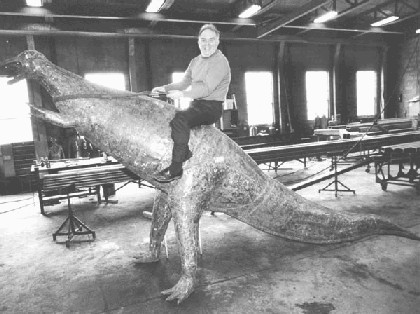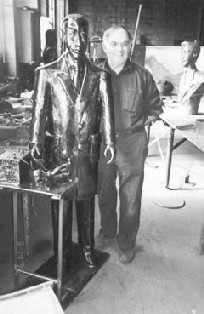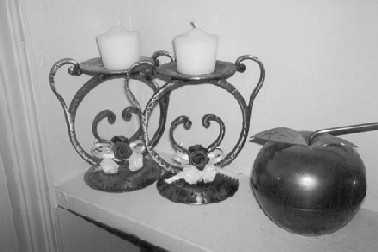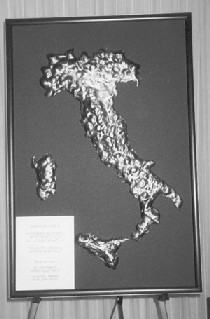|
|
| |
|
|
| The
Catalyst Converter: The Artwork of Salvatore Lamonica |
| By
Colin Donelle |
|
|
| Salvatore
Lamonica speaks highly of his metal sculptures and with good merit.
Without formal education or training he has produced incredible works
of art. Using only a hammer and an electric torch, he has created pieces
that earn the respect and admiration of critics, art or otherwise.
Lamonica was born in 1930 in Piraino, Messina –
a small agriculture community of 5,000 in Sicily. Unable to go to
school because of the war, he looked for job opportunities. He refused
to adapt to the norms of society, finding joy in blacksmithing rather
than as a farm hand.
|
 |
| Salvatore
Lamonica with the dinosaur sculpture that took nine months to
create. |
|
“I
didn’t like to work on the farm,” Lamonica says bluntly.
By the
age of seven Lamonica had begun working with a local blacksmith, learning
how to use the basic tools (axe and pick) and gradually refining his
techniques. At nineteen he decided to leave this lifestyle and took
a job with the Police Force at Carabinieri. He spent five years with
them before immigrating to Canada.
“The
opportunities in Italy were limited; I saw a good future in Canada,”
he explains. |
| He
left Sicily in 1954 with his girlfriend and moved to a small apartment
on Preston Street. With only a 30-day visa, he had to find full-time
employment or get married.
“And
so I got married,” he says with a smile.
Lamonica
took a job at Auto Ironworks and worked there until 1973 when the
shop closed. Then he found a job with Trudel and McAdam Ironworks.
He stayed until 1997 when he was injured on the job (leaving him with
little strength in his right hand). During this time he had two children
with his wife Carolina: Antonio and Nancy.
Consistent
throughout all of this were his creative aspirations. Ever since he
was a child, Lamonica knew that he had this desire to create art within
him, but it was repressed by those around him.
“My
father would tell me if I go to the blacksmith I have to do blacksmith
work and nothing else,” he says.
Lamonica
can also remember his father kicking him when he first learned of
his creative aspirations. Against his father’s wishes, Lamonica
would build sculptures out of clay and then destroy them, so as not
to get in trouble. Some of his most memorable creations were of a
bicycle and various animals. |
| When
he came to Ottawa he continued to fight against this oppression. At
Auto Ironworks he was not allowed to use any steel for anything outside
of approved projects. So, he would take the scrap metal and build
his pieces secretly in his spare time. When he was done he would sneak
them home inside old pizza boxes.
“I
support my family and with no money to buy steel, what could I do?”
Lamonica asks.
But he
refused to sell any of his sculptures. Instead, he used them to decorate
his own home or gave them to family and friends.
“If
I sold them it would seem wrong, like stealing for money,” Lamonica
says.
Finally,
when he went to Trudel and McAdam Ironworks, he found the support
he needed. |
 |
| Salvatore
Lamonica with his statue of William Marconi, the inventor of the
radio. The statue now stands at Villa
Marconi. |
|
| “They
allowed me to use the scrap metal and work on them when I didn’t
have anything else to do,” he says.
One of
these creations, too hard to hide, was a 17-foot-long Tyrannosaurus.
It took him nine months to finish and once done received public appraise.
Lamonica gladly holds up a picture taken by the Ottawa Citizen
and recounts of newscasts from CJOH. The dinosaur was also put on
display at the Rideau Centre.
Some
of Lamonica’s greatest sculptures include a pig, a mermaid,
the Santa Maria (Columbus’ boat), a life-size Arab
Jesus, a cactus, replica maps of Sicily and Italy, and household items
such as a liquor cart, plants and candle holders. It’s easy
to see the imagination and skill that he must possess when you see
the artwork he has produced. It’s also easy to see how he uses
his blacksmithing skills as a catalyst for a free-wheeling imagination.
Lamonica’s
most notable sculpture is his interpretation of William Marconi. Marconi,
an Italian with no educational training, invented the radio one day
while playing during a storm with some wire. These two men are very
similar – neither had any educational training yet both were
able to invent and create simply using their natural talents.
“I’ve
seen blacksmiths with no experience (in sculpturing metal) try to
accomplish what I’ve done,” says Lamonica. “It’s
very hard to do that. I’m very proud; I never had the opportunity
to go to school to learn something so I do this to give back.”
I’ve
heard it said that we are all products of our circumstances. I never
knew exactly what this meant until I met Salvatore Lamonica. Talking
to him I began to understand that these pieces are not simply a hobby,
but an avenue for his creativity. The sculpture of his boss, William
Marconi, the Arab Jesus, these are all simply abstractions of his
own life experiences. They represent not only his own individuality,
but also the collective identity of all Italians. |
|
|
| |
This
article was originally published in the April 2002 issue of Il
Postino.
|
|
| back
to the top |
|




